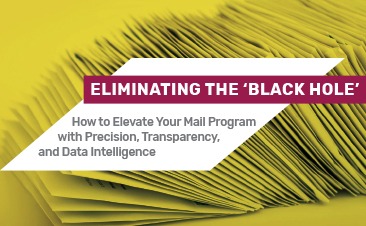 Don’t pass up the chance to elevate your mail program with precision, transparency, and data intelligence!
Don’t pass up the chance to elevate your mail program with precision, transparency, and data intelligence!
You put an enormous amount of time, effort, and money into your communication strategy, and a successful mail program is central to that strategy. Inducting your valuable mailings into a black hole and hoping for the best won’t produce desired results.
Take this quick three question quiz – then read our free eBook, Eliminating the ‘Black Hole,’ to find out if you think of your mail as a big, black hole!
A major retailer has developed a multi-channel promotion for its big, national blowout sale, which includes emails to draw consumers’ attention to coupons coming in the mail. Best practices suggest the retailer should:
A: Use the official service standards of the Postal Service™ as a guide for timing the emails and mail drops, hoping the mail arrives when desired.
B: Knowing that the USPS® current performance on Marketing Mail™ varies from facility to facility and by day of the week, monitor the progress of each mailpiece in the mailstream and adjust email messages to correspond with actual variations in mail delivery.
When a major weather event hits after a utility has mailed its monthly invoices, the company’s best option is to: A national charity has mailed its major fall fundraising campaign but hasn’t received any Business Reply Envelopes with donations in its lockbox. The organization:
A: Closely monitor the storm and try to use local forecasts as a guide for staffing to manage remittance mailings as they are returned.
B: Manage remittance returns with precision because the utility is able to monitor weather-related delays and recovery efforts, down to the local level, for inbound and outbound mail throughout the country.
A national charity has mailed its major fall fundraising campaign but hasn’t received any Business Reply Envelopes with donations in its lockbox. The organization:
A: Calls its vendors and local USPS business representative looking for answers but gets no results.
B: Develops a report showing that not only had the campaign been printed, dropped with the USPS, and delivered to recipients within the targeted timeframes, but about 15,000 pieces of inbound response mail should have already been received in the lockbox. Armed with the appropriate documentation, the charity approaches the Postal Service, which ultimately tracks down the misdirected mail.
